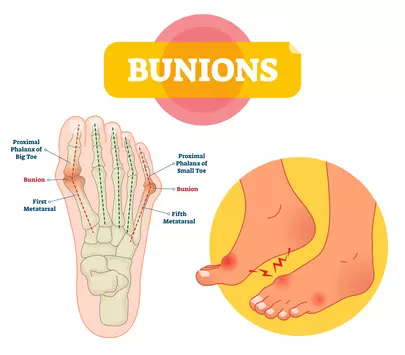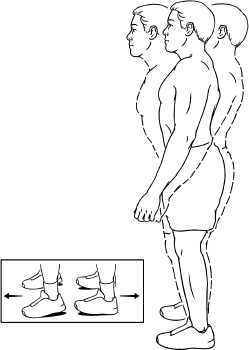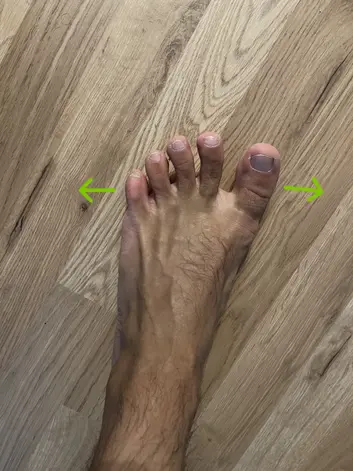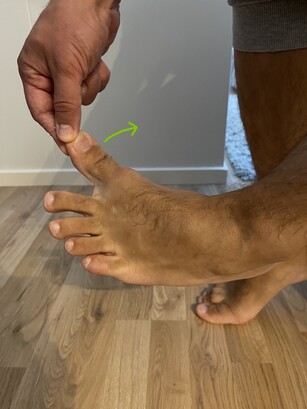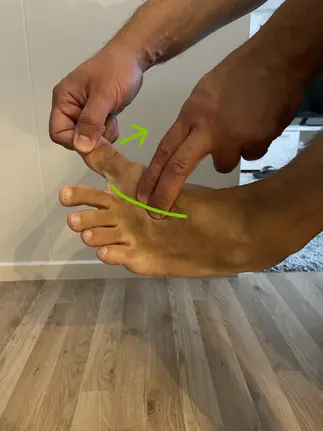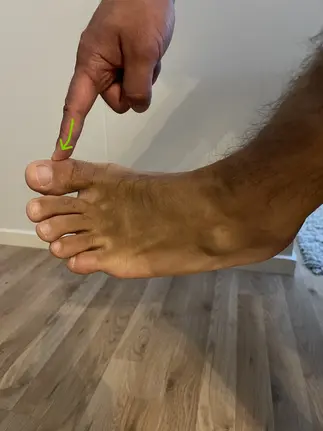How to Fix Bunions: The Definitive Guide
This is a complete guide to correcting bunions.
In this guide you will learn:
- How to fix bunions with exercises
- How to choose the best bunion corrector
- How to spot early signs of bunions and how to prevent bunions
- Lots more
Let’s get started.
Chapter I: Introduction to Bunions
Definition of Bunions (Hallux Valgus)
Bunions are bony bumps. They forms on the base of a big toe or pinky toe.
Hallux Valgus refers to a bunion in a big toe.
credits: klmlabstore
What Causes Bunions
How do you get bunions? There is no straight answer, but the research has found predisposing factors:
- Female sex
- Age
- Constricting footwear
- Family history
- Flat feet and overpronation
Females have more tendency toward bunions than males (15:1 ratio according this study).
Even celebrities can’t avoid bunions. Take a look at 50 famous person with hallux valgus.
How Bunions Impact Foot Health
Hallux Valgus is basically a misalignment of a big toe. Even though this issue is ‘local’, it can compromise other parts of the foot.
Here is what studies have found out about how bunions influence foot and body posture and health:
-
Leads toward plano valgus and flat feet
-
Leads toward anteroposterior sway
-
Misalignment of 2.-5. toes
Understanding The Bunions Symptoms and Progression
Bunions can be categorized into 4 different stages. Each stage of bunions marks the specific deformity level.
- No deformity
- Mild deformity
- Moderate deformity
- Severe deformity
credits: ankleandfootcenter
Early signs of a bunions are:
- Reduced/Limited active movement of a big toe
- A bulging bump on the outside of a big toe
- Swelling, pain and soreness in the base of a big toe
Moderate and severe bunions can lead to more pain, arthritis and difficulty finding a comfortable sneakers.
CHAPTER II: HOW TO DEAL WITH BUNIONS
In this chapter, you will learn how to get rid of bunions. You will learn:
HOW TO FIX BUNIONS WITH EXERCISES
Exercising can be an effective way to improve the function of a big toe and foot in general, and to prevent bunions from further deformity.
Let me show you best foot exercises for bunions that you can do at your home.
Perform these exercises two times per day.
If you’re not sure if you have a hallux valgus, I recommend you do these exercise anyway. These are one of the most effective exercises to prevent bunions, increase hallux plantarflexion and abduction strength and toe grip strength.
Toes Spread-out
Start by sitting on a chair. Place one foot on a ground and spread out your toes and hold for 2s. Repeat for few minutes. This is one of the best toe exercise for bunions.
Toes Extension
While holding your foot on a ground, lift up only toes, without lifting your foot. Repeat for few minutes for best effect.
Assisted Toe Abduction
Grab your big toe with your hand and assist your big toe through abduction (moving away from 2.toe).
This exercise is great as a pain relief exercise for bunions.
Passive Toe Abduction with Massage
Using your hand to help you abduct your big toe (moving away from 2.toe) and simultaneously massaging adductor hallucis muscle that are in between 1. and 2. toe.
This muscle is often painful and contribute to hallux valgus posture.
Toe Abduction with Resistance
You can use resistance band or manual resistance to help improve big toe strength even more.
Just place your finger on a big toe (medial side) and push with your big toe toward abduction (away from 2.toe).
Repeat 10 times.
Towel Grip
Spread a towel beneath your foot. Then curl your toes around the towel and pull it towards you. This is a great way to strengthen foot muscles.
Toe Traction
Grab your big toe with your hand and gently pull your big toe away from your foot.
Big toe traction is a great way to relieve pain and pressure of a big toe joint.
Hold for 30s.
What to Do When Bunions Hurt
I’ve been searching for the best approach to relieve pain from bunions and I have found the best remedies for bunions are:
- Foot orthoses
- Night splints
- Dynamic splints
- Manual therapy
- Taping
- Exercise program for foot muscles
- Botox injections
Here you can read more about the study on effective non-surgical interventions for hallux valgus.
Best Orthotics for Bunions, including Shoes, Insoles, Cushion Pads and Much More
Shoes For Bunions
One of the best men’s shoes for bunions in my opinion. Here is why:
- Light and easy to slip on
- High arch support
- Temperature regulating
- Stylish
They have everything that’s recommended for preventing/relieving the pain from bunions.
These shoes are a walking shoes.
Check the current offer on Amazon.
These are a women best shoes for bunions because they deliver everything that’s crucial to combat bunions.
- Arc support
- Wide toe box
- Easy to slip on
And you can choose from six different colors. If you ask me, they are the most fashionable shoes for bunions on the market.
See the actual price and reviews from others on Amazon.
Best Insoles For Bunions
Created for daily use when walking, these insoles give you better shock absorption, heal support and relieve the pressure off the ball of your foot.
The seller offers a refund if you don’t like this product, just don’t open the bag with scissors.
More than 59k reviews.
See the offer on Amazon.
Designed for high impact sports. Provide excellent support for arch with polyurethane foam.
Extra support for heel with heel plug.
Made of nylon. Sizes for men and women.
Check out the price on Amazon.
How to Prevent Bunions
Key factors to prevent bunions are:
- Choose the right shoes for you
- Take care of your foot posture
- Maintain strong big toe abductor and plantarflexors
- Avoid high heels when unnecessary
And that’s it.
What are the best shoes for bunions? – Comfortable shoes that are not too short/tight. You shouldn’t struggle to slip your feet into shoes. Avoid pointy and narrow shoes. Choose shoes with built-in arch support.
Take care of your foot posture – Flat feet and/or overpronation are the most common foot posture issues that go together with bunions. I’ll cover guides for correcting these in separate articles.
What helps bunions is avoiding putting pressure on a ball of your foot, distributing the pressure evenly to other parts of your foot and having a healthy muscles around toes.
Foot Surgery for Bunions
Sometimes is exercising not so effective against bunions and further medical intervention is required.
I made a list of most common foot surgeries that doctors use when treating hallux valgus.
- Osteotomy
- Arthrodesis
- Exostectomy
- Resection Arthroplasty
Explore more about these procedures on orthoinfo.
Chapter III: Frequently asked Questions about bunions
Are bunions hereditary?
Yes, mostly. Bunions are often a result of a poor foot structures (inherited). Some people have foot structure that are prone to bunions.
Do toe separators and cushion pads really work for bunions?
Toe separators and cushion pads can relieve pain and ease pressure of big toe. But they can’t reverse bunions.
Will my bunion get worse?
Most likely, yes. But some bunions are less progressive so it’s important to focus on exercising and using a proper shoes.
What are the treatment options for bunions?
Conservative or surgical. Conservative include exercising, physical therapy, massage and orthotics.
Do all bunions require surgery?
To restore the full alignment in toes, the surgery is the only way. Other conservative modalities can help you relieve pain, slow down progression and improve a foot posture to a certain degree.

